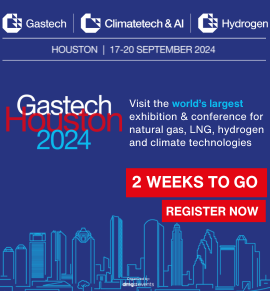March 25, 2025 [Hydrogen Fuel News]- Breaking New Ground in Hydrogen Production
Clyde Hydrogen, a dynamic startup spun out from the University of Glasgow’s School of Chemistry, is pioneering a new approach to hydrogen production with its “decoupled electrolysis” technology. This innovative process represents a significant departure from traditional electrolysismethods, which typically split water into hydrogen and oxygen in a single step. Instead, Clyde Hydrogen’s system separates this process into two distinct stages.
The first stage involves an electrochemical reduction that produces a reduced mediator solution. This is then converted into hydrogen gas in the second stage, using a catalytic generator. The system’s design allows hydrogen and oxygen to be generated at different times, rates, and even locations. This flexibility solves a key challenge in traditional electrolysis by enabling hydrogen production even when renewable energy sources, such as solar or wind, are inconsistent. Additionally, the process yields hydrogen at high pressures, reducing the need for expensive compression systems down the line.
James Peck, CEO of Clyde Hydrogen, emphasized the importance of these advancements, stating that the technology is designed to better integrate low-quality, intermittent renewable power into clean hydrogen production. This ability not only makes the system more efficient but also positions it as a promising solution for the evolving renewable energy market.
A Milestone Achievement
Clyde Hydrogen recently announced a milestone achievement with the successful operation of its beta-stage decoupled electrolysis prototype. For the first time, the company managed to produce hydrogen continuously using the system, operating at pressures exceeding 100 bar. By scaling up and testing both its electrochemical reduction and hydrogen generation subsystems together, the company has proved the viability of its process.
What’s particularly noteworthy is that this milestone was reached under manual control conditions, providing strong validation of the technology’s capabilities before transitioning to fully automated systems. Peck highlighted the strategic importance of this success, noting, “This is an important step for the team as it enables us to demonstrate that the system works continuously and gives confidence that we can begin the build of the full prototype in preparation for a commercial pilot project next year.”
This success has also attracted attention outside the lab. Clyde Hydrogen has signed a memorandum of understanding (MoU) with PlusZero, a green hydrogen producer, to showcase the technology in a real-world setting.
The Road Ahead
Looking to the future, Clyde Hydrogen is poised to scale up its operations. The company plans to develop a fully integrated pilot system by late 2025, incorporating automation for improved efficiency and scalability. Following this, a commercial demonstration system is scheduled for launch in 2027.
To fund these steps, Clyde Hydrogen has opened a £5 million investment round. Backed by pre-seed funding from organizations like Zinc and grants from the Scottish Government’s Hydrogen Innovation Scheme and the Net Zero Technology Centre, the company is building momentum to take its technology to market. Expansion plans also include refining the production process and growing its team to meet anticipated demand.
Additionally, the company’s partnerships with organizations such as PlusZero highlight its commitment to bringing practical, scalable hydrogen solutions to the forefront. These collaborations will not only demonstrate the real-world applicability of Clyde Hydrogen’s technology but also enhance its potential role in decarbonizing sectors where hydrogen is a key component.
Implications for the Hydrogen Economy
Clyde Hydrogen’s milestone isn’t just a win for the company; it has broader implications for the entire hydrogen economy. By addressing barriers such as reliance on constant renewable energy and costly compression systems, its decoupled electrolysis technology could lower the cost of hydrogen production. This economic benefit makes green hydrogen more competitive with fossil fuels, accelerating its adoption across industries.
Scalability is another significant factor. The modular approach of their system means it can be adapted to various scales and requirements, from smaller operations in remote areas to large-scale industrial production. Furthermore, the ability to integrate with inconsistent renewable power sources reduces operational downtime, maximizing efficiency.
This technology also aligns well with global net-zero goals. By offering a cost-effective and practical method of green hydrogen production, it paves the way for increased use of hydrogen in energy storage, transportation, and heavy industries. Governments and private stakeholders seeking to meet emissions targets could greatly benefit from adopting systems like those developed by Clyde Hydrogen.
Transforming Hydrogen Production for a Net-Zero Future
Clyde Hydrogen’s achievement marks a significant step forward in the pursuit of sustainable energy solutions. Their decoupled electrolysis technology not only demonstrates innovative engineering but also highlights the practical possibilities of integrating renewable energy with hydrogen production. With ambitious plans for commercialization and a clear focus on addressing industry challenges, the company is well-positioned to influence the future of hydrogen energy.
While the road to widespread adoption may still face hurdles, the potential of Clyde Hydrogen’s technology to reshape the hydrogen landscape is significant. If successful, their advancements could help propel green hydrogen into the mainstream, enabling industries and countries to move closer to their net-zero aspirations. This landmark progress proves that the hydrogen economy is no longer just an idealistic vision but a rapidly unfolding reality.
Free Trial: Access 13,300 Tank Terminal and Production Facilities
13,300 tank storage and production facilities as per the date of this article. Click on the button and register to get instant access to actionable tank storage industry data











